The Seiko Astron, released to great fanfare in 2012, tells time by receiving GPS signals anywhere on Earth. Was it a world-beater in our test? Click here to read our in-depth review of the original Seiko Astron GPS solar watch, with photography by Robert Atkinson.
The last time Seiko called a new watch “Astron,” the future of timekeeping changed forever. Launched on Christmas Day, 1969, the original Seiko Astron watch was the world’s first commercially available quartz wristwatch. At the time, Seiko said of the Astron, “Someday, all watches will be made this way.” Today, it’s saying the same thing about the new Astron. Is Seiko right? Let’s find out. If you have not read about it, the Astron is an analog, solar-powered watch that receives GPS satellite signals and adjusts to the precise local time anywhere on Earth. It recognizes all 39 time zones, besting the top mechanical watches, which can display 37, with a manual reset. The Astron covers the globe by first determining its location using GPS, then comparing that information with an onboard database that divides the Earth’s surface into one million squares, each of which is assigned to a particular time zone. That is something no other watch can do.
The Seiko Astron differs from watches that receive terrestrial radio signals from atomic clocks. So-called RC (radio-controlled) watches receive signals when they are within range of stations in the United States, Japan, the United Kingdom, Germany and China, so they do not offer global coverage. The Astron works anywhere, even in the middle of an ocean or desert, in Antarctica, or on a Tibetan mountaintop. Seiko Astron watches also automatically recognizes which time zone they are in, while RC watches do not.

The Astron also differs from Citizen’s original Satellite Wave, which receives GPS signals, but lacks a GPS geo-location function so it does not change time zones automatically. Finally, though the Astron is a GPS receiver that knows precisely where it is, it can’t direct you to that new restaurant downtown, or tell you how far it is to the 14th green. It uses GPS solely to tell time.
When you take an Astron out of the box, it may have to be charged. The Astron is powered by light – any type of light will charge its battery, but sunlight is the most efficient energizer. The charging status is displayed via an “E – F” (Empty – Full) indicator between 9 and 10 o’clock. The power reserve when fully charged is two months in active mode and six months in sleep mode. In sleep mode, the Astron does not display the time until it “wakes up” by being exposed to light. It takes only six minutes of sunlight to provide enough power for the Astron to run for one day, but going from empty to fully charged requires 65 hours of sunlight. The GPS receiver will not operate when the watch is low on power, so regular charging is important. The Seiko Astron performs two basic types of operations with GPS signals: it can automatically and manually sync to a single satellite to make sure its local time display is accurate, and it can be manually triggered to change time zones, which requires at least four satellite signals.
The Astron automatically attempts to sync with a single GPS signal once each day. The sync can be set in motion by exposure to the sun or another strong source of light. The Astron’s programming tells it that if a strong light source is present, there’s a good chance it can receive a signal. If the Astron acquires a signal, it remembers when that happened. On subsequent days, if the watch is covered by clothing or otherwise blocked from light, it searches for the signal at the same time as the last successful attempt, assuming the chances for reception are good. To make sure it’s always on time, the Astron can also receive leap-second data. Leap seconds are added about every 18 months to account for the Earth’s slowing rotation. The most recent was added on June 30, 2012.
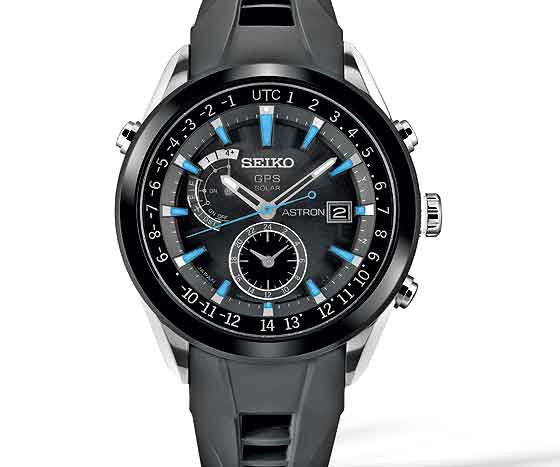
Manually syncing to a GPS signal is accomplished with a simple push of a button. Because GPS satellites carry atomic clocks, their time signals are incredibly accurate. (Seiko cites the figure of one second in 100,000 years.) Regular syncs keep the Astron right on time. While the Astron’s sync functions allow it to keep time with great accuracy, the movement itself, without syncing, offers typical +/-15 seconds per month quartz performance. If you go an extended time without a sync, some error may creep into the display. Changing time zones can only be accomplished manually, and it is a bit more complex. The process is initiated by pushing and holding a button for six seconds. Once the button is released, the Astron begins to search the sky for GPS signals. In this mode, the seconds hand becomes an indicator that provides signal search status updates. The hand tallies each newly acquired signal by pointing to the corresponding hour marker, so for example after acquiring one, then two, then three satellite signals, the seconds hand points to 1, then 2, then 3 on the dial. When the search is complete, the seconds hand points to a small “Y” on the seconds track to indicate that the minimum four signals were acquired, or to “N” to indicate that the search was not successful. The small indicator between 10 and 11 o’clock also points to “4+” if the search was successful. If at least four signals were received, the hour and minute hands slowly march to their new positions to indicate the new local time.
If you prefer to set your watch to your destination time when you board the plane, Seiko Astron watches can also be reset to a new time zone manually and placed in airplane mode to turn the GPS receiver off. Adjusting for daylight saving time is another manual operation. The Astron knows its location, but it does not know the laws governing DST in all locations. A press of a button turns DST on and the DST setting is displayed on the indicator at 9 o’clock.
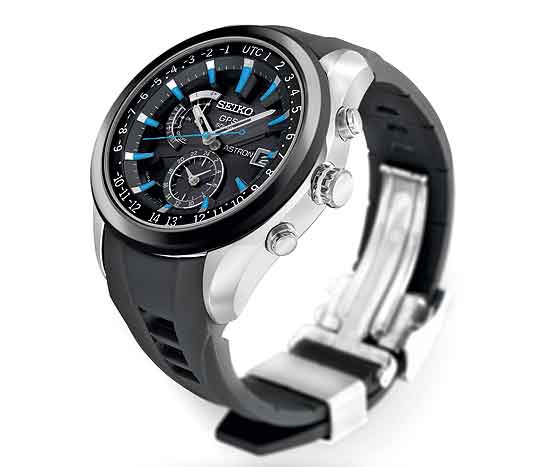
To receive any satellite signals, the Astron has to be able to “see” the sky. The owner’s manual warns that outdoors, amid trees or tall buildings, receiving signals, and changing the time zone in particular, may be difficult. We tested the Astron in 12 outdoor locations to get a feel for how much sky has to be visible to pick up a signal. Our test locations included deep urban canyons in midtown Manhattan, an urban park, the center of a smaller city (White Plains, N.Y.), a small-town main street (Tarrytown, N.Y.), and three rural settings, including a wooded trail. Given the warnings, the watch performed surprisingly well. We picked up a single satellite signal in the center of Times Square and on Madison Avenue surrounded by people and tall buildings. The only setting where we could not receive a signal was on a wooded trail beneath a dense canopy of trees, which is effectively the same as being indoors.
We also had better than expected luck changing time zones, which requires four signals. We achieved success amid skyscrapers on Madison Avenue at 53rd Street, though we had to walk around a bit, pointing the watch in different directions (attracting some glances from passers-by). We also acquired four signals in downtown White Plains surrounded by mid- and high-rise buildings, and in two locations under a few trees on the main street in Tarrytown. As expected, the rural settings presented no challenges. We acquired the largest number of signals, eight, in a large park in a rural setting. We were unable to change time zones on the wooded trail, in the center of Times Square, and in front of the New York Public Library on Fifth Avenue.
Changing the time zone takes anywhere from 30 seconds to two minutes. In an age of instant gratification, some may view this as an annoying delay, but we found that the process can be fun. The Astron is essentially a wrist-mounted satellite detector, and because GPS satellites are not geosynchronous – they orbit the Earth and so are always moving in the sky – you never know where they are, or how many are overhead. So, changing time zones is like searching for satellites overhead. The Seiko Astron GPS solar technology requires a large housing, and the Astron’s case measures a substantial 47 mm by 16.5 mm. Though it’s on the large side, it is comfortable to wear. With curved lugs and a shaped strap, our test watch hugged the wrist. The holes in the strap are closely arranged to allow a good range of adjustability. Our test watch was also fairly light at 146 grams. However, the thick case and strap combine to create a bulky package, making it a tight fit under some cuffs. On my 7 3/4-inch wrist, a standard Nordstrom dress shirt cuff would not button over the watch, and with other shirts, pulling the cuff back to check the time sometimes proved a challenge.
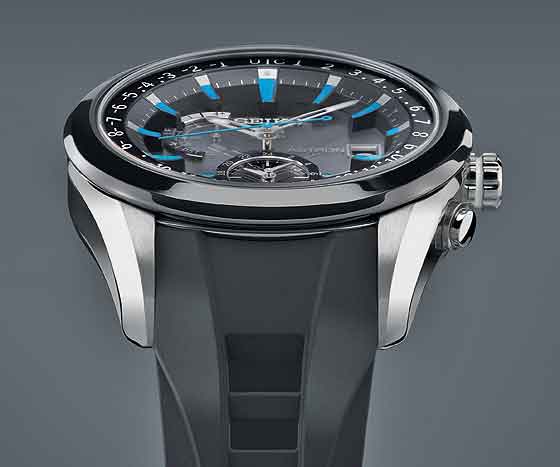
Seiko says that the silicon strap has been specially treated, and it does have a silky smooth feel. The strong vanilla scent associated with some straps is also pleasantly absent. However, when it comes to strap colors, Seiko offers the famous Ford Model T option – you can have any color you like, as long as it’s black. The keeper on the strap is a substantial metal piece with a nice brushed finish and the Seiko name engraved. The single-folding deployant buckle is easy to adjust and to open and close. It’s well polished and instills confidence. The buckle is nicely curved and, like the case, hugs the wrist.
When it comes to aesthetics, the Astron’s look is appropriately space-age. Physics geeks might recognize a slight resemblance to the CMS detector at the Large Hadron Collider, near Geneva. The shaped hour markers float above a deeply three-dimensional display. Steeply stepped rings lead down to the dial. This arrangement is visually dramatic, though it causes the hands, and the seconds hand in particular, to be a bit too short. In a watch designed to offer ultimate accuracy, the seconds hand should not fall a few millimeters short of the seconds track. We also noticed that while the blue seconds hand on our test watch coordinated with the color of the hour markers, it offered less contrast than a white hand would provide. In some cases design trumps practicality. The translucent dial has a sunburst finish, which is appropriate given the Astron’s solar charging capability. The second time zone (or home time) is displayed in 24-hour fashion on a subdial at 6 o’clock. The date and second time zone are easy to read, though more could be done to differentiate the small hands on the second-time-zone display. Silver-colored beveled edges on raised dial indications show attention to detail.
The Astron’s dial layout is fairly standard until you reach the curving, multi-function indicator located between 9 and 11 o’clock. A single small hand indicates the state of the charge, whether the watch is in airplane mode, whether daylight saving time is indicated, and, during a time-zone reset, whether the required four satellite signals were acquired. The flat sapphire crystal is treated with Seiko’s “Superclear” coating, which the brand says reduces light reflections by 99 percent. It lived up to its name during our test.
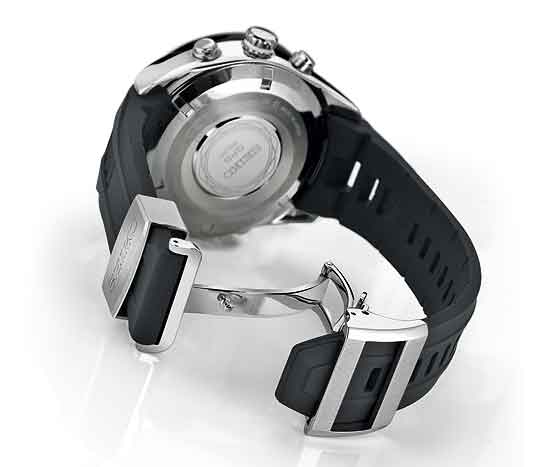
On the Seiko Astron watch we tested, the blue Lumibrite on the hour markers was lumpy and irregular. Other Astrons we’ve seen exhibit the same flaw. Though it’s visible only on close inspection, for some owners, close inspection is a daily ritual, and once the eye finds a flaw, it becomes hard to ignore. The Lumibrite at the tips of the hour and minutes hands was smooth. The seconds hand has no luminous material. According to Seiko, Lumibrite charges fast and lasts long. In our test, we exposed the Lumibrite to direct sunlight for 30 minutes to see how long it would last on a full charge. After its tanning session, the Astron was sealed away from the light. We checked it hourly for the first 12 hours. After that much sun, many watches would light up like a fireworks display. The Astron did not. But what it lacked in lumens, it made up for in stamina. Indeed, the Lumibrite lasted a full 18 hours.
During the first three hours of our test, the time could be read easily in the dark. The glow was sufficient, but not impressive. After three hours, reading the time required allowing our eyes to adjust to the darkness for a minute or two. That was due to reduced luminous output, and the fact that the small amount of luminous material on the tips of the hands makes them difficult to distinguish without a close look. After 18 hours in the dark, the Astron could still be read, though just barely. Our test watch had a stainless-steel case with a polished finish interrupted only by a satin finish applied on top of the lugs. All Seiko Astron models have ceramic bezels because the material improves signal reception compared with steel. The solid caseback screws in, and the inscription on the caseback indicates 10-bar, or 100-meter, water resistance.
The screw-down crown has a softly knurled finish that looks nice but does not aid the grasp. In fact, we found the crown to be a bit slippery. Fortunately, the Astron’s crown is not used very often. Because the Astron offers lots of functionality, it comes with multiple sets of instructions. An accordion-like seven-page quick-start guide covers the basics. For more information, there’s a thicker, printed owner’s manual. To get the full story, load the included CD, sit back, and enjoy the 57-page unabridged Complete User Guide. The Astron comes in several flavors, and beyond the aesthetic variations, there’s one difference some may want to note. On our test watch, the “city ring” did not actually identify any cities. Rather, it simply offered numbers indicating offsets from GMT. Other Seiko Astron watch models take the more traditional (and informative) approach and identify major cities along with the time-zone offsets.
At the end of the day, the Astron is likely to polarize enthusiasts. Some will think the GPS “middle of nowhere” functionality is cool, and others won’t. Some may consider it a gimmick, or a gadget watch, and to those, the price, $2,300, will be too steep. If you appreciate the engineering know-how required to create an ultra-low-energy GPS receiver for the wrist, or if you want to own the first global GPS time-zone watch, or if you just want to be able to count the GPS satellites overhead, the Astron may be an appealing package. The Seiko Astron’s popularity is certainly growing. In January 2013, tennis champ Novak Djokovic, heretofore an endorser of the prestigious Swiss watch brand, Audemars Piguet, switched his wrist loyalty from Switzerland to Japan, signing on as a global “brand ambassador” for Seiko and receiving the gift of a new Seiko Astron GPS Solar watch from Seiko president Shinji Hattori on the eve of the 2014 Australian Open. Seiko has since released new iterations of the Astron, including a version with a chronograph.
So, will all watches be made this way some day? The short answer is no. To reach a point where many watches are made this way, Seiko will have to make the package much smaller and much less expensive. The odds favoring universal adoption are certainly longer than they were in 1969.
SPECS
Manufacturer: Seiko Watch Corp., 8-10 Toranomon 2-Chome, Minato-ku, Tokyo 105-8467, Japan
Reference number: SAST009
Functions: Hours, minutes, central seconds, date, perpetual calendar, second time zone, GPS-controlled world time with 39 time zones
Movement: Caliber 7X52, solar charging
Case: Stainless steel with ceramic bezel, flat sapphire crystal with nonreflective treatment, fully threaded stainless-steel caseback, screw-down crown, water-resistant to 100 meters
Strap and clasp: Silicone strap with stainless-steel folding clasp
Dimensions: Diameter = 47 mm, height = 16.5 mm, weight = 146 grams
Variations: With black dial, titanium case and bracelet with black hard coating, limited edition of 2,500 pieces (ref. SAST001, $3,850); with black dial, titanium case and bracelet (ref. SAST003, $3,100); with black dial, titanium case and bracelet with black hard coating (ref. SAST007, $3,200)
Price: $2,300
To download any of these original photos of the Seiko Astron as wallpaper for your desktop, click here.
This article was originally published in 2014 and has been updated.


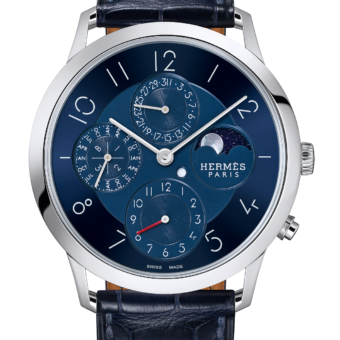



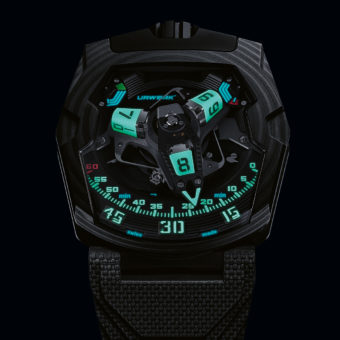
Super hodinky .Už nikdy nechci jiné. Při dobíjení baterie na slunci doporučuji hodinky ponořit do sklenice s čistou vodou . Hodinky se na přímém slunci přehřívají vlivem slunečního záření,studená voda zabranuje nadměrnému přehřívání hodinek a možnému poškození . Ve sklenici s vodou možno nabíjet na přímém slunci i čtyři hodiny až celý den ,záleží na intenzitě slunečního záření. Děkuji Seiko za super hodinky. Jiří
Thanks a lot Seiko for all the times.
Bought the Astron 5 years ago couldn’t notice that its hardly decreased in value?
Also the BEST watch I’ve ever owned simply beautiful workmanship perfect timing LOVE IT!
Wow what an informative read…. excellently put together…
I am trying to set the daylight savings time on wristwatch citizen been.
I have the 8x and love it. I am able to acquire GPS time zones while I’m on the plane if I’m by a window, usually between 4 and 5 sat’s. Love the titanium as well. Ballin’ watch for a decent price. Highly recommended.
This watch ROCKS! Wish I had more wrists! Great while I’m out hunting.
Best watch I’ve ever owned. Wish I had more hands! Great while I’m out in the bush.
This particular watch, i.e., the 7×52 caliber series has been replaced in late 2015 by the 8×53 series. These are BIG improvements in reduced size and appearance. I own the SSE047 with a white dial, and I must say it does everything Seiko claims, and also the SSE047 in titanium (very light and comfortable) is the easiest to read in legibility of the seven new 2015 models. Great watch!!!
This is a beautiful watch! I wish Seiko would make 41.5mm and a 37.5mm versions like the Omega Planet Ocean.
The best website ever dude!
What a wonderful article, so well written in an unbiased fashion. Having just bought an Astron, I concur with everything written. I just love standing at my bedroom window and catching the morning sunlight the Astron syncs with the satellites, so super cool. This really is a watch that stands alone and is indeed the future of time. Everyone should have one!
I am a very happy owner of an Astron (SSE017J). Even though I have a small wrist, it does not look too big and I can get the band tight enough so that it is comfortable. The watch itself looks great and the occasional horologists that I meet are always fascinated by the piece. This year, my Astron automatically picked up the 2015 leap second and applied it correctly at appropriate local time. (I videoed the leap second, all it does is hold all hands for the extra second at 00:00 GMT.) I wear the watch often (including during fieldwork) and it has tolerated the first year of ownership very well. To me, its attractive features are; its looks good, it is solar powered with a long battery backup, and it automatically synchronises its time.
This Astron is a 7X and Seiko has added a later version called 8X, with a few small differences eg, the day indicator is at the 4 position instead of the 3 position.
I like the Casion MR-G watch which is also a GPS watch and I think also includes radio for those who live in areas where the radio is close enough to receive signals.
I’m not putting Seiko watches down. They have exceptional manufacturing quality.
BUT I really don’t see the functionality of this GPS watch any more than it’s superb accuracy in its own time zone. If I wanted to check the time in London or more zones when I was in New York it would be cheaper for me and much more quick to change the locality button on my Casio Sports Pro-trek Solar Quartz (dual-time display) watch. With this Seiko and any ‘world time’ watches I’d have to count…er… forwards… or backwards…er… how many hours was it…?
Agreed, it’s a well-made watch, no doubt. the only one to get would be the Limited Edition, if you were to spend that much for it.
Best article On this I have read.After that just falling in love with mine all over again. Got mine about 2 years ago. If I read write the watch will adjust to different time zones automatically? I always adjust mine manually after stepping off the plane. Am I just being impatient. Please help someone.cheers Andrew.
The tech is nice, but if I go high tech instead of traditional mechanical, then the Apple watch will provide the above for little money, as it will regularly sync with the iphone which is linked to local atomic time. Hence, while cool, I think that this kind of single focus high tech watches will gradually lose appeal.
In their arrogance, Apple have overlooked the battery, someone please tell them about solar powered watches, also though the Techs inside the box, it need not look like a box, thats called styling.
The Astron is in a diiferent category altogether from Apples latest watch. It functions independently without pairing to any phone. I have the watch for almost two years now and simply love it. Theoretically if u leave the watch by the window with access to afew hours of direct sunlight permanently, it can continue to function and remain accurate for afew years, even decades, untill the capacitor dies. And that will take many years.
Mike, that was a very comprehensive, well researched and written article. I loved some of the picture language eg, “An accordion-like seven-page quick-start guide”. Like all Seiko products, it’s a quality product but the price is probably a bit steep for most punters at a minimum of $2,300.
That being said, there are dozens of mechanical watches whose accuracy isn’t as good being sold for much, much more.
Thanks for an interesting and informative article.
Addendum: I had a look at this watch this morning at my local jewellery store. It’s priced $2,700 in Australian dollars and is big, chunky, but elegant. I may just have to buy one.
PS: I gave the jewellery store staff this link so potential buyers could read your review.
I have been wearing my citizen Skyhawk AT for the past 5 years. It is radio controlled and solar powered, it uses an AM frequency at 3 am every morning to set it’s self. I’m very intrigued by this watch, time will tell if it holds up and is reliable. Seiko makes very nice watches some cheap, and some high end. I’m not a price tag shower haha I just want it to work.
I bought mine a month ago. SSE001 Limited Edition and am totally amazed by this watch. Awesome wrist wear. So precise it’s almost scary. I paid $3,600 with tax and was glad to pay it. Serious watch.
I am a woman and actually love this watch. Would it look stupid on the wrist of a largish woman?
Hey, if you like it, don’t worry about anyone who thinks it might look stupid. Life is too short.
Great comment
It’s still a Seiko and that leaves me cold.
Seiko watches are always a good option to buy because they are best in quality & reliability.
Great watch with nice functions, but to expensive for me.
how about gps finding? if you want to locate yourself how long does it take to find it?
It can’t. read the review! Finally, though the Astron is a GPS receiver that knows precisely where it is, it can’t direct you to that new restaurant downtown, or tell you how far it is to the 14th green. It uses GPS solely to tell time.
I hope Seiko could cut down the price. They are way too expensive. With the current price, one could buy a full function GPS unit with additional useful functions.
Could not find my comment and answer to it. Please help.
Thanks for expected cooperatioon.
I. Gindin
Hi Igor,
We emailed you a response to your question about the Omega download on 1/24. Check your junk folder just in case. It should be from Stephen Brown.
How much is the wrist watch Seiko astron
The watch costs $2,300.
I’m sure this is a nice
just both astron 4 hours ago and iam very impress with my black astron ceramic with black rubber strap and buckle spend us$1500,-at seiko AD in jakarta
So, one minor flaw in the GPS system that could be interesting or aggravating depending on where you live . . .
This watch apparently does not break down your GPS coordinates strictly based upon what time zone you are in. Seiko has mapped the globe into 1 million squares and assigned each of them a time zone. What possible problem does this have? What happens when a square doesn’t follow the time zone boundary and actually falls into two time zones? Seiko assigns each square a time zone and the instruction manual of the watch even mentions that if you are close to the time zone boundary that the GPS sync might assign the watch the incorrect time zone. Nothing is mentioned as to how Seiko chooses which time zone to assign squares that fall into two time zones: 51% of area or are they using population centers to make a guess where people on that boundary might live? The earth is 510 million square kilometers so if you are using 1 million grid squares that gives you 510 square kilometers in each map square (approximation: you can’t really divide the area of a sphere into neat squares like this and I don’t know *exactly* what Seiko did with their mapping). So approximately 22.6 kilometers on each side of a map square. What happens if the time zone boundary runs right down the middle of a square that you live in? Do you have a 50% chance that Seiko assigned a time zone to the square, and if you live on “wrong” side of the square you walk out of your house each day and the watch syncs to the wrong time zone? Same problem can happen for people living in one of the corners of a map square that Seiko picked to be a different time zone than your house. This could be a major problem.
I am no mapping expert so I don’t know which method presents a greater data set, but with the extremely low cost of data storage in modern methods it seems that Seiko could have done a better job by using the internal database of the watch to store the coordinates of the time zone boundaries. Lots of these boundaries are on straight lines that are simple to map, and of the boundaries that move around a lot I am sure it wouldn’t take too much storage to cover those areas with all the coordinate changes. Thus we could have had a data set where the watch calculates what time zone you are in based upon real boundaries, not boundaries made up of squares which CANNOT approximate any sort of diagonal boundary (has to be either horizontal or vertical to fit the border of a square) and still has issues with horizontal or vertical boundaries that don’t fall exactly on the boundaries of the squares stored in internal memory.
Maybe I am complaining about something that would only take a 99% great watch up to 100%. But I’m just an average idiot on the street and I still see a MAJOR problem with the approach Seiko has taken.
You worry too much Aaron… be happy :)
Easy for you to say. When looking at buying this seemingly high-tech Seiko watch I have to take into consideration that I am one of the people that lives extremely close to a time zone border. My life is scheduled almost entirely around one time zone, but I can’t have a watch that sets itself to the wrong time zone when I leave the house. Short of buying the watch to try it out I have no way of knowing what it will do.
Interesting commentary. I know people who drive across time zones daily to go to and from work. Maybe the Astron would wear itself out adjusting twice daily.
Read the review. The time zone setting can be done two ways: GPS or manual override. Both methods have to be activated by the user. The usual time-sync is only for time.
Time sync requires just 1 good satellite reception and will be attempted automatically once a day. Time zone sync requires 4 or more good satellite receptions and will only be attempted when triggered manually.
So even if you live on a border or travel all the time, there is no risk of the Astron jumping back and forth between two time zones.
The reason Seiko made it function like this is simple, when most people are on a plane, they usually want to switch to the destination time zone before arrival. So time zone gps setting is kind of useless in that case. It really is only useful when you are kind of clueless about where you are and what the time zone is.
I have owned this watch for a week (SAST 003) and your review is spot on. I purchased it online and was concerned about the size as I didn’t want it to look like I was a child trying on my dads watch. While the face is large, it feels very comfortable and lightweight and does not look too large on my 6- 3/4 wrist. The only flaws I have found is that there is not enough lumibrite on the hour and minute hands and the watch is very difficult if not impossible to read in the dark. The other “problem” is that the crystal is so clear that when in bright sunlight the watch is sometimes hard to read because of all the brilliant reflection coming off the watch face. That said, the watch is beautiful and has a super cool factor. I am hoping the “newness” factor wears off soon as I am getting tired of constantly staring at it……
This is a follow up to the above review. I have now had this watch for 7 years and it has become worthless junk. $1,800 down the toilet. The battery or capacitor (who knows) has died and I’ve been informed my 2 watch makers that they cannot be replaced as this particular battery type is no longer made. I’ve been told that this being Seiko’s first GPS watch it was designed poorly and put too much strain on the battery. As far as I can tell through internet research this is a well known problem and many of these watches are now crapping out. I’m very upset as a $1,800 watch should last more than 7 years or at the very least be repairable. My advice to anyone considering buying this watch either new or used should STAY AWAY. For sure if looking at used.
it will carry the great history in watch making
I like watches that have a special function as well as the time. Breitling Emergency 2 also comes to mind and now the Seiko GPS. Seiko at a reasonable price too!
I read the article with interest and expected the watch to be a lot more expensive. Well done Seiko!
A Swiss mechanical watch company would not have made one if these but if they did, the price would be closer to $20K.
iran-esfahan-park center No:360-watches gallery (mr.Haj sabbagh)
oooom i see this seiko in my workplace.in every day
2.300-3000$ !!!